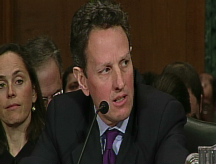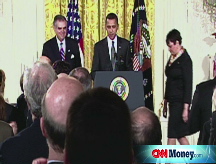Bonds boosted by record auction
The government sold a record $40 billion worth of 2-year notes in an oversubscribed auction.
NEW YORK (CNNMoney.com) -- Treasurys rallied Tuesday after a record 2-year note auction attracted more bidders than available notes.
Bonds were also boosted by hopes that the Federal Reserve will offer more details Wednesday about the possibility that it may step in and buy its own debt, which would provide a surge of demand.
The central bank began its two-day policy-making meeting Tuesday. With interest rates in a range of 0% to 0.25%, there's not much room to go lower. But investors will be keen to hear what the Fed says.
"They are positioning themselves to keep rates low for a longer period of time," said Ross Junge, senior vice president of portfolio management at Aviva Investors North America. But it's the possibility that the central bank may outline plans for buying debt that was helping prop up Treasury prices, he added.
Stimulus and auctions: As the national economy struggles in recession, the Obama administration is working to push through a $825 billion financial rescue package.
Spending programs and financial rescue packages will require the government to auction off historic amounts of debt in order to fund the programs. The Treasury was scheduled to auction $135 billion worth of debt this week, on top of the $120 billion worth of debt brought to market last week. The federal deficit already exceeds $1 trillion.
On Tuesday the government auctioned a record $40 billion worth of 2-year notes with a bid-to-cover ratio of 2.69, meaning there was over $100 billion worth of bidders for $40 billion of debt.
The government also auctioned $32 billion worth of 28-day bills Tuesday.
On Monday the government auctioned $29 billion worth of 13-week bills, $28 billion worth of 26-week bills, and $8 billion worth of 20-year TIPS (Treasury Inflation-Protected Securities).
And on Thursday the Treasury is scheduled to sell a record $30 billion worth of 5-year notes.
Debt prices: Treasurys reached record highs at the end of 2008 as spooked investors looked for a safe haven. But the influx of supply had pushed prices sharply lower of late. Tuesday's bounce was partly due to investors finding value in those lower levels.
The 10-year Treasury rallied 1-3/32 to 110-19/32, and its yield fell to 2.53% from 2.64% late Monday. Bond prices and yields move in opposite direction.
The 30-year longbond surged 3-4/32 to 123-29/32, and its yield dipped to 3.23% from 3.38%. The 2-year note edged higher 2/32 to 100-4/32, and its yield fell to 0.81% from 0.84%.
The yield on the 3-month note rose to 0.14% from 0.10% Monday. The 3-month bill has been used as a gauge of confidence in the marketplace because investors tend to shuffle funds in and out of the bill as they asses risk in other places.
Lending rates: The 3-month Libor rate held steady at 1.18%, according to Bloomberg.com. The overnight lending rate, meanwhile, ticked lower to 0.22% from 0.23% Monday.
Libor, the London Interbank Offered Rate, is a daily average of rates 16 different banks charge each other to lend money in London, and it is used to calculate adjustable-rate mortgages. More than $350 billion in assets are tied to Libor.
Two credit market gauges were mixed, showing a modest rise in confidence but less cash availability.
The so-called "TED" spread, a measure of banks' willingness to lend, narrowed to 1.04 percentage points from 1.08 percentage point Monday. The bigger the TED spread, the less willing investors are to take risks. The rate surged as the credit crisis gripped the economy, but has since fallen off as central banks around the world have lowered interest rates and pumped the economy with liquidity.
Another market indicator, the Libor-OIS spread, ticked up to 0.95 percentage points from 0.94 percentage point, late Monday. The Libor-OIS spread measures how much cash is available for lending between banks, and is used for determining lending rates. The bigger the spread, the less cash is available for lending.
Talkback: Get your economic questions answered. E-mail realstories@cnnmoney.com with questions about jobs, housing, energy, student loans, credit cards, Americans' spending and savings habits, etc., and they could be answered on air as part of the first CNN Money Summit. ![]()




